
The Portuguese man o' war, also known as the man-of-war or bluebottle, is a marine hydrozoan found in the Atlantic Ocean and the Indian Ocean. It is considered to be the same species as the Pacific man o' war or bluebottle, which is found mainly in the Pacific Ocean. The Portuguese man o' war is the only species in the genus Physalia, which in turn is the only genus in the family Physaliidae.
The pelagic zone consists of the water column of the open ocean and can be further divided into regions by depth. The word pelagic is derived from Ancient Greek πέλαγος (pélagos) 'open sea'. The pelagic zone can be thought of as an imaginary cylinder or water column between the surface of the sea and the bottom. Conditions in the water column change with depth: pressure increases; temperature and light decrease; salinity, oxygen, micronutrients all change. Somewhat analogous to stratification in the Earth's atmosphere, but depending on how deep the water is, the water column can be divided vertically into up to five different layers.
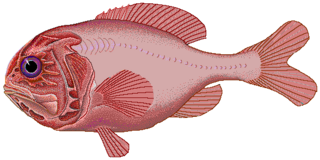
Slimeheads, also known as roughies and redfish, are mostly small, exceptionally long-lived, deep-sea beryciform fish constituting the family Trachichthyidae. Found in temperate to tropical waters of the Atlantic, Indian, and Pacific Oceans, the family comprises about 50 species in eight genera. Slimeheads are named for the network of muciferous canals riddling their heads.

Pelagic fish live in the pelagic zone of ocean or lake waters—being neither close to the bottom nor near the shore—in contrast with demersal fish that live on or near the bottom, and reef fish that are associated with coral reefs.

Pelagia noctiluca is a jellyfish in the family Pelagiidae and the only currently recognized species in the genus Pelagia. It is typically known in English as the mauve stinger, but other common names are purple-striped jelly, purple stinger, purple people eater, purple jellyfish, luminous jellyfish and night-light jellyfish. In Greek, pelagia means "(she) of the sea", from pelagos "sea, open sea"; in Latin noctiluca is the combining form of nox, "night"", and lux, "light"; thus, Pelagia noctiluca can be described as a marine organism with the ability to glow in the dark (bioluminescence). It is found worldwide in tropical and warm temperate seas, although it is suspected that records outside the North Atlantic region, which includes the Mediterranean and Gulf of Mexico, represent closely related but currently unrecognized species.
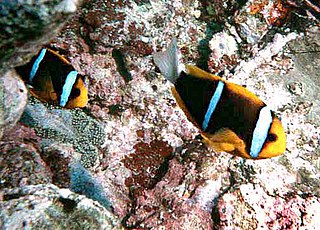
The orange-fin anemonefish is a marine fish belonging to the family Pomacentridae, the clownfishes and damselfishes, found in the Western Pacific north of the Great Barrier Reef from the surface to 20 m, to include the Pacific Ocean between Queensland, Australia, and New Guinea to the Marshall and Tuamotus Islands. It can grow to 17 cm in length.

Nomeidae, the driftfishes, are a family of percomorph fishes found in tropical and subtropical waters throughout the world. The family includes about 16 species. The largest species, such as the Cape fathead, Cubiceps capensis, reach 1 m in length.

The demersal zone is the part of the sea or ocean consisting of the part of the water column near to the seabed and the benthos. The demersal zone is just above the benthic zone and forms a layer of the larger profundal zone.
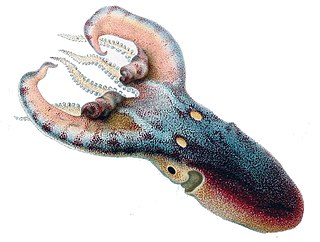
The common blanket octopus or violet blanket octopus is a large octopus of the family Tremoctopodidae found worldwide in the epipelagic zone of warm seas. The degree of sexual dimorphism in this species is very high, with females growing up to two meters in length, whereas males grow to about 2.4 cm. The first live specimen of a male was not seen until 2002 off the Great Barrier Reef. Individual weights of males and females differ by a factor of about 10,000 and potentially more.

Chrysaora hysoscella, the compass jellyfish, is a common species of jellyfish that inhabits coastal waters in temperate regions of the northeastern Atlantic Ocean, including the North Sea and Mediterranean Sea. In the past it was also recorded in the southeastern Atlantic, including South Africa, but this was caused by confusion with close relatives; C. africana, C. fulgida and an undescribed species tentatively referred to as "C. agulhensis".

The Pacific sea nettle, or West Coast sea nettle, is a widespread planktonic scyphozoan cnidarian—or medusa, “jellyfish” or “jelly”—that lives in the northeastern Pacific Ocean, in temperate to cooler waters off of British Columbia and the West Coast of the United States, ranging south to México. The Pacific sea nettle earned its common name in-reference to its defensive, ‘nettle’-like sting; much like the stinging nettle plant, the sea nettle’s defensive sting is often irritating to humans, though rarely dangerous.

Spawn is the eggs and sperm released or deposited into water by aquatic animals. As a verb, to spawn refers to the process of freely releasing eggs and sperm into a body of water ; the physical act is known as spawning. The vast majority of non-mammalian, non-avian and non-reptilian aquatic and/or amphibious lifeforms reproduce through this process, including the:

The round sardinella is a species of ray-finned fish in the genus Sardinella found in both sides of the Atlantic Ocean and the Mediterranean Sea.
The pelagic goby, also known as the bearded goby, is a species of true goby from the family Gobiidae, native to the southeastern Atlantic Ocean. It is currently the only known member of its genus.

Helicolenus dactylopterus, blackbelly rosefish, bluemouth rockfish, and bluemouth seaperch, is a species of marine ray-finned fish belonging to the subfamily Sebastinae which is classified within the family Scorpaenidae. This Atlantic species is a typical sit-and-wait predator with a highly cryptic coloration.
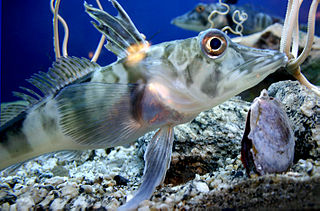
Chionodraco hamatus is a species of marine ray-finned fish belonging to the family Channichthyidae, the crocodile icefishes. It is found in the Southern Ocean.

Chilomycterus reticulatus, the spotfin burrfish, spotted burrfish, Pacific burrfish, spotfin porcupinefish or few-spined porcupinefish, is a species of fish in the genus Chilomycterus, which is part of the porcupinefish family Diodontidae.

The smooth lumpfish is a species of marine ray-finned fish belonging to the family Cyclopteridae, the lumpfishes and lumpsuckers. This species is found in the northern Pacific Ocean. It is the only species in the monospecific genus Aptocyclus.

Trachurus lathami is a species of fish in the family Carangidae and the genus Trachurus, the jack mackerels. Common names include rough scad and horse mackerel in English, as well as chinchard frappeur (French), chicharro garretón (Spanish), jurel, and carapau, garaçuma, surel, and xixarro. It is native to parts of the western Atlantic Ocean, including seas off the eastern coasts of North and South America and the Gulf of Mexico.
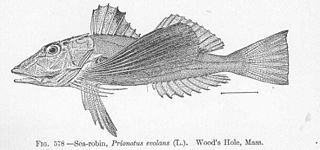
Prionotinae is a subfamily of demersal, marine ray-finned fishes, part of the family Triglidae. The fishes in this subfamily are called sea robins and are found in the Western Atlantic and Eastern Pacific Oceans, the other two Triglid subfamilies are called gurnards.






















